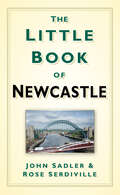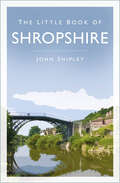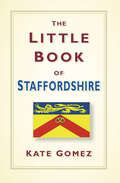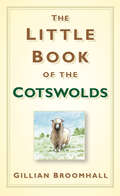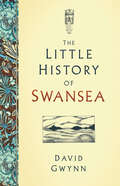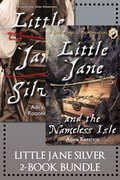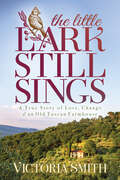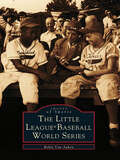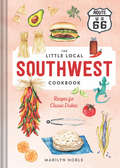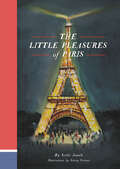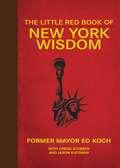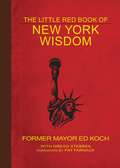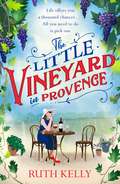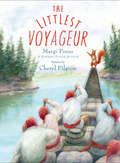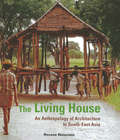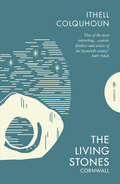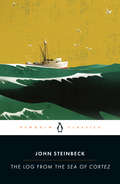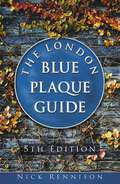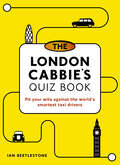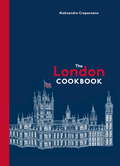- Table View
- List View
The Little Book of Newcastle
by John Sadler Rosie SerdivilleThe Little Book of Newcastle is a funny, fast-paced, fact-packed compendium of the sort of frivolous, fantastic or simply strange information which no-one will want to be without. Here we find out about the most unusual crimes and punishments, eccentric inhabitants, famous sons and daughters and literally hundreds of wacky facts (plus some authentically bizarre bits of historic trivia). John Sadler’s new book gathers together a myriad of data on Newcastle. There are lots of factual chapters but also plenty of frivolous details which will amuse and surprise. A reference book and a quirky guide, this can be dipped in to time and time again to reveal something new about the people, the heritage, the secrets and the enduring fascination of the city. A remarkably engaging little book, this is essential reading for visitors and locals alike.
The Little Book of Shropshire
by John ShipleyThe Little Book of Shropshire is an intriguing, fast-paced, fact-packed compendium of places, people and events in the county, from its earliest origins to the present day.Here you can read about the important contributions Shropshire has made to the history of the nation, and meet some of the great men and women, the eccentrics and the scoundrels with which its history is littered.Packaged in an easily readable ‘dip-in’ format, visitors and locals alike will find something to remind, surprise, amuse and entertain them in this remarkably engaging little book.
The Little Book of Staffordshire
by Kate GomezDID YOU KNOW? A gravestone in the churchyard of St Edwards at Leek suggests that the deceased died at the ripe old age of 438! The ashes of Hanley-born Sir Stanley Matthews are buried beneath the centre circle at Stoke’s Britannia Stadium. The sun sets twice in Leek each summer solstice. Sarah Westwood from Lichfield was the last woman to be executed at Stafford Gaol, in 1844. THE LITTLE BOOK OF STAFFORDSHIRE is a compendium of fascinating information about the county, past and present. Contained within is a plethora of entertaining facts about Staffordshire’s famous and occasionally infamous men and women, its towns and countryside, history, natural history, literary, artistic and sporting achievements, customs ancient and modern, transport, battles and ghostly appearances. A reliable reference book and a quirky guide, this can be dipped into time and time again to reveal something new about the people, the heritage, the secrets and the enduring fascination of the county. A remarkably engaging little book, this is essential reading for visitors and locals alike.
The Little Book of the Cotswolds
by Gillian BroomhallThe Little Book of the Cotswolds is a veritable smorgasbord of Cotswold miscellany, packed with fascinating titbits and all manner of factual frippery – from Cotswold lions to puppy dog pies. The region’s strangest traditions, its most eccentric inhabitants, blood-curdling murders and right royal connections combine with humorous cartoons to make this quirky little book difficult to put down.
The Little History of Swansea
by David GwynnMuch has changed in Swansea over the years and this short but comprehensive history chronicles the development of the city from the earliest times to today.The Little History of Swansea traces the growth of the medieval town, the rise of the Port of Swansea, the industrial heritage of the area and the fate that befell the town during the Second World War. Here you can read about the odd and unusual happenings, as well as the more traditional history that has made the city what it is today.
The Little Jane Silver 2-Book Bundle: Little Jane Silver / Little Jane and the Nameless Isle
by Adira RotsteinPresenting both of Little Jane Silver's piratical adventures in one special bundle! Little Jane Silver is the granddaughter of the notorious pirate Long John Silver. Growing up on her parents' ship, she vows to become a real pirate. As her ship is pursued by a mysterious pirate hunter, and on her own for the first time, Little Jane must grow up fast and find the courage to undergo the most important test of her young life: a quest to save her family. In Little Jane Silver and the Nameless Isle, Little Jane is on a quest to the Nameless Isle – a journey only her parents have survived. Will she rise to the task and save her parents' treasure from the pirate hunter Fetzcaro Madsea, or will the treachery of the voyage prove too daunting? These two books are exciting journeys back to swashbuckling, lawless days on the open seas, but viewed uniquely through the eyes of an adventurous young girl. Includes: LIttle Jane Silver Little Janes Silver and the Nameless Isle
The Little Lark Still Sings: A True Story of Love, Change & an Old Tuscan Farmhouse
by Victoria SmithIn this memoir of life abroad, a married couple discovers the charms and challenges of Italy when they buy their Tuscan dream home.Happily married for two decades, Victoria and Larry decide to move to their favorite hilltown in Tuscany. But what begins as a romantic adventure soon becomes a drama of change and perseverance. Alongside Italy’s wonders—its beauty, art, architecture, food, and history—come the challenges of daily life in a foreign culture, surviving the chaos of construction, navigating narrow roads, longing for friends, stumbling with language, and so much more. As these struggles undermine Victoria’s confidence which, in turn, wears on Larry’s patience.Though they share a dream, they discover their personal goals are different. His are to study and write, hers are to create the perfect Italian home and make friends. He needs quiet time; she needs his help. From the joys and near disasters of renovating an ancient stone farmhouse to celebrating their first Italian dinner party, Victoria learns about Italy, herself, and their marriage. In The Little Lark Still Sings, she shares their humorous and character-stretching experiences with uplifting insight and wisdom.
The Little League® Baseball World Series (Images of Sports)
by Robin Van AukenLittle League Baseball is a microcosm of American history, filled with countless anecdotes, good fortune, adversity, and hope. In 1947, when the first Little League Baseball World Series was played, there were seventeen leagues in two states. Since then, Little League has achieved global recognition and has touched the lives of children and families in more than one hundred countries. The World Series is the culmination of dedication and teamwork in more than sixteen thousand games ending in a sixteen-team tournament in Williamsport, Pennsylvania. The Little League Baseball World Series remembers the history of the tournament and its role in bringing together communities. More than two thousand five hundred spectators witnessed the first championship game in 1947, when the Maynard Midgets took home the trophy, and the results were printed in newspapers around the country. Now, millions more tune in to ABC's Wide World of Sports and ESPN for live coverage of the final game. Little League Baseball has enriched the lives of more than thirty million boys and girls who have worn a Little League uniform. Well-known figures such as Derek Jeter, Kevin Costner, and Pres. George W. Bush were all Little League players. The Little League Baseball World Series celebrates this rich baseball history and the best teams the league has produced through the years.
The Little Local Southwest Cookbook: Recipes For Classic Dishes
by Marilyn Noble30 classic Southwest recipes to treasure The Little Local Southwest Cookbook brings the essential flavors of the American Southwest to your table. Spice up your snack time with Sangria Blanca and Bacon-Wrapped Jalapeno Poppers, and liven up your lunches with Red Chile Chicken Enchiladas or Carne Seca Chimichangas. No matter where you are, grab some chile powder and transport yourself to the desert warmth to enjoy the region’s indigenously influenced cuisine. Written by a regional food expert and beautifully illustrated, this little cookbook is the perfect gift for those who dream of the sunny Southwest.
The Little Local Vermont Cookbook: Recipes For Classic Dishes
by Melissa Pasanen30 classic Vermont recipes to treasure The Little Local Vermont Cookbook brings the natural flavors of the Green Mountain State to your table. Whether you’re starting the day with Maple Bacon Skillet Biscuits or enjoying a midday meal of Cheddar Ale Soup, this sweet little book will pack a powerful punch of nostalgia. No matter where you’re eating, you can round out your evening with Harvest Stuffed Squash, followed by a batch of classic Maple Ginger Cookies, and you’re guaranteed to feel like you’re back in Burlington. Written by a regional food expert and beautifully illustrated, this cookbook is the perfect way to jog mountain memories.
The Little Pleasures of Paris
by Leslie Jonath Lizzy StewartTake an enchanting tour of Paris's most charming places, objects, and pasttimes in this lovingly compiled Francophile handbook. Organized by season, The Little Pleasures of Paris takes the reader through a year's worth of quintessentially Parisian experiences, from secret gardens bursting with roses to exotic plumage at the city's bird market, candied violets at Paris's oldest sweet shop, dazzling colors in the stained glass at Sainte-Chapelle, and more. The friendly text and whimsical illustrations make this delightful ebook a poetic letter to the City of Light. Unusual details that might otherwise go unnoticed are celebrated and offer a uniquely intimate perspective in this triomphe of je ne sais quoi and joi de vivre!
The Little Red Book of New York Wisdom
by Gregg Stebben Jason Katzman Ed KochWhether you love its pace or are mystified by its immensity, New York City has a seemingly limitless capacity to spark both refreshingly blunt observations and eloquent descriptions of its daily life and motion. It has inspired countless artists, musicians, and even politicians, all of whom embody the essence of the city: profound, prophetic, quirky, amusing, tough, and amazingly varied.Inside you'll find words of wisdom from a plethora of noteworthy New Yorkers, including:Joe NamathDonald TrumpEdie FalcoWoody AllenMarilyn MonroeJoan RiversRudolph GiulianiBette MidlerSpike LeeAnd many, many more!New York boasts a cast of colorful characters like nowhere else, and in The Little Red Book of New York Wisdom they'll tell you all about their beloved home, as only a real New Yorker could. A thought-provoking collection inspired by life in the world's greatest city.
The Little Red Book of New York Wisdom (Little Red Bks.)
by Gregg Stebben Ed Koch Pat FarnackWhether you love its pace or are mystified by its immensity, New York City has a seemingly limitless capacity to spark both refreshingly blunt observations and eloquent descriptions of its daily life and motion. It has inspired countless artists, musicians, and even politicians, all of whom embody the essence of the city: profound, prophetic, quirky, amusing, tough, and amazingly varied.Inside you’ll find words of wisdom from a plethora of noteworthy New Yorkers, including:Joe NamathDonald TrumpEdie FalcoWoody AllenMarilyn MonroeJoan RiversRudy GiulianiBette MidlerSpike LeeAnd many, many more!New York boasts a cast of colorful characters like nowhere else, and in The Little Red Book of New York Wisdom they’ll tell you all about their beloved home, as only real New Yorkers could.
The Little Red Stroller
by Joshua FurstOne handy little stroller is passed from family to family in this uplifting picture book celebration of community, diversity, and sharingWhen Luna is born, her mommy gives her a little red stroller. It accompanies her and her mommy through all the activities of their day, until she outgrows the stroller and is able to pass it down to a toddler in her neighborhood who now needs it. And so the stroller lives on, getting passed from one child to the next, highlighting for preschool readers the diversity of families: some kids with two mommies, some with two daddies, some with just one parent, and all from different cultures and ethnicities. This simple, cheerful book is a lovely portrait of the variety and universality of family.
The Little Swedish Kitchen
by Rachel Khoo'A joy to behold' Yotam OttolenghiLearn how to cook the Swedish way with this beautiful book of over 100 delicious recipes. Spring picnics on the archipelago; barbecues at the summer cabin; cosy autumnal suppers; and dark snowy winters filled with candlelight, gingerbread and glögg - the Swedes love to celebrate every season via the food they eat. Complete with stunning location and food photography, and over 100 beautiful, fuss-free recipes, this cookbook lets you in on what the Swedish call lagom . . . the art of not too little, not too much, but just the right amount. Explore the nation's simple and balanced approach to cooking, sample their best-loved ingredients and discover a must-try cuisine that is about far more than just meatballs, fika and cinnamon buns . . . _________________Inside you'll find recipes for sunny days or cosy evenings, celebrations or nights curled up at home, such as:· POACHED CHICKEN WITH QUICK PICKLED STRAWBERRY SALAD. The ultimate barbecue salad. Replace the chicken with grilled halloumi cheese for a delicious vegetarian alternative.· PEAS, POTATOES AND CHICKEN IN A POT. The one dish delight: summer comfort food that's perfect for midweek. · MIDSUMMER MERINGUE CROWNS. The Swedes have been wearing flower crowns since long before festival-goers discovered them. Now you can make beautiful edible ones for parties or puddings.· PLUM TOSCA CAKE. This Swedish favourite, named after Puccini's opera, is filled with tart plums and sweet almonds._________________'I am so ready to race home and devour these fun, effortless and beautiful recipes that just beg to be cooked' Melissa Hemsley'The magic of Sweden's beautiful seasons comes alive . . . a real celebration of seasonal Swedish home cooking and tradition with Rachel's trademark inspirational twists!' Donal Skehan
The Little Vineyard in Provence: A warm, escapist read for 2021
by Ruth KellyDreaming of your next holiday? Let Ruth Kelly transport you away to the sunny climes of Provence. Ava needs to escape.Stuck in a dead-end job, her husband Mark has left her with a mountain of debt and no clue as to when he'll be back. When she receives the news that her grandfather has passed away, Ava is shocked to learn he has left his entire vineyard, Chateau Saint Clair, to her.Fresh coffee and croissants for breakfast, a glass of red with the handsome local waiter Jacques; Ava starts to feel quite at home. But it would be madness to walk away from her marriage, to take a chance on a place she fell for as a child - wouldn't it?Fans of Jenny Colgan, Lucy Diamond and Veronica Henry will want to join Ava for a glass of wine as the sun sets on the terrace at Chateau Saint Clair.
The Little(r) Museums of Paris: An Illustrated Guide to the City's Hidden Gems
by Emma JacobsDiscover a new side of Paris, hidden in plain sight, with this beautifully illustrated guide to the city's smaller collections and best-kept secrets, from artists' studios to scientific museums. A visit to Paris can often seen like a highlight reel -- the Louvre, the Musee d'Orsay, the Eiffel Tower. But Paris isn't only about the big attractions; in fact, some might say it's the offbeat destinations that hold the greatest treasures. The Little(r) Museums of Paris takes a whimsical journey through these smaller destinations, from the fantastical to the bizarre, offering both a guide to the city and inspiration for armchair travelers. Rather than traveling by neighborhood, this charming guide explores the different types of institutions nestled within Paris, from time capsules like the Musee Nissim de Camondo to explorations of the world beyond the city limits, including the Institute of the Arab World. Readers will peek behind the curtains of artists' apartments and into the microscopes of collections of scientific oddities. Each entry opens up a new world of adventure, with a description of the museum's collection, as well as a short history, watercolor illustrations, and a miniature map. For residents and visitors alike, the captivating illustrations and deeply-researched yet approachable writing will encourage greater appreciation of the cultural diversity, history, and colorful characters that give Paris that je ne sai quoi.
The Littles Take A Trip
by John PetersonThe Little family takes a trip out from their house and into the woods and encounter many exciting and scary adventures.
The Littlest Voyageur
by Margi PreusA red squirrel, Jean Pierre Petit Le Rouge, stows away on a canoe to fulfill his dream of joining a group of voyageurs--men who paddle canoes filled with goods to a trading post thousands of miles away. It is 1792 and unbeknownst to a group of voyageurs traveling from Montreal to Grand Portage, an intrepid squirrel, Jean Pierre Petit Le Rouge, sneaks onto their canoe. Le Rouge is soon discovered because he can't contain his excitement--mon dieu he is so enthusiastic. The smells! The vistas! The comradery! The voyageurs are not particularly happy to have him, especially because Le Rouge rides, but he does not paddle. He eats, but he does not cook. He doesn't even carry anything on portages--sometimes it is he who has to be carried. He also has a terrible singing voice. What kind of voyageur is that?When they finally arrive at the trading post Le Rouge is in for a terrible shock--the voyageurs have traveled all those miles to collect beaver pelts. With the help of Monique, a smart and sweet flying squirrel, Le Rouge organizes his fur-bearing friends of the forest to ambush the men and try and convince them to quit being voyageurs. Written by a Newbery honor author, the book has over 20 black-and-white illustrations.A Junior Library Guild Selection
The Living House
by Roxana WatersonThe Living House was the first book of its kind to present a detailed picture of the house within the social and symbolic worlds of Southeast Asian peoples. A pioneering title that has become a classic, this exemplary text draws on many sources of information, from architects and anthropologists, to the author's own firsthand research.As it probes into the centrally significant role of houses within Southeast Asian social systems, The Living House reveals new insights into kinship systems, gender symbolism and cosmological ideas, ultimately uncovering basic themes concerning the idea of life and life processes themselves. A vivid picture emerges of how people shape buildings and buildings shape people, as rules about layout and uses of space have an impact on social relationships.Although intended first and foremost as a work of anthropology, The Living House will also appeal to architects, scholars and the interested general reader.
The Living Stones: Cornwall (Pushkin Press Classics)
by Ithell ColquhounA classic travelogue by Britain's foremost female surrealist painter, which immerses the reader in a dreamlike Cornwall where landscape and legend meet&“Her responses to the aura of place are keen, and her eye for detail is excitingly sharp&” — Sunday Times&“She is sensitive to the ways of wind and water, the flowers and birds and trees&” — Country LifeIn the midst of the 2nd World War, surrealist painter Ithell Colquhoun withdraws from London to Cornwall, searching for a studio and a refuge from the Blitz, as well as from a shattered marriage. So begins a profound and lifelong relationship with Britain's westernmost county. It is a land of granite ridges and lush valleys, surrounded by sea and steeped in myth, where the ancient Celtic past makes contact with the present. There she finds a hut with no running water or electricity, and lovingly brings it to life, creating a haven for her creative pursuits, and slowly coming to think of these rivers, hills and caves, seen in every season, as her true home.Drawn to the sacred and the beautiful, the wild and the weird, Colquhoun writes about Cornwall as a living landscape, where every tree, standing stone and holy well is a palimpsest of folklore - and perhaps a place where everyday reality connects to the world beyond. In prose as gorgeously dreamlike as it is sharply witty, this inimitable artist gives us a travelogue deeply attuned to natural rhythms, local atmosphere and the eerie beauty of a place that is as much legend as it is water and rock.
The Log from the Sea of Cortez: The Grapes Of Wrath / The Harvest Gypsies / The Long Valley / The Log From The Sea Of Cortez (Mandarin Classic Ser. #2)
by John Steinbeck Richard AstroIn the two years after the 1939 publication of Steinbeck's masterful The Grapes of Wrath, Steinbeck and his novel increasingly became the center of intense controversy and censorship. In search of a respite from the national stage, Steinbeck and his close friend, biologist Ed Ricketts, embarked on a month long marine specimen-collecting expedition in the Gulf of California, which resulted in their collaboration on the Sea of Cortez. In 1951, after Ricketts' death, Steinbeck reissued his narrative portion of the work in memory of his friend and the inspiration for Cannery Row's "Doc". This exciting day-by-day account of their journey together is a rare blend of science, philosophy, and high-spirited adventure. This edition features an introduction by Richard Astro.
The London Blue Plaque Guide: 4th Edition
by Nick RennisonConnecting people with places, London’s distinctive Blue Plaque scheme highlights the buildings where some of the most remarkable men and women in our history and culture have lived and worked. From Richard Burton to Karl Marx, Marie Stopes to Jimi Hendrix, this fully updated 4th edition of The London Blue Plaque Guide has over 900 entries and provides an essential companion to the famous people who have made their homes in the city. It includes updated maps and a useful list of names by profession as well as location. As the definitive guide to the fascinating historical figures who have lived in London, it will be invaluable to residents and tourists alike.
The London Cabbie's Quiz Book: Pit Your Wits Against the World's Smartest Taxi Drivers
by Ian BeetlestoneGet up to speed on London trivia and get inside the heads of black cab drivers with questions from the famously difficult test they have to pass.Pay a visit to London and a black cab will probably be one of the first things you will see. The London taxi drivers are almost as famous as the black cabs in which they drive; this is mainly due to their in-depth knowledge of London and ability in taking their occupants to their desired destination amid the congestion and the chaos that you often find when travelling through London’s streets. London taxi drivers go through stringent training to obtain their licence, they need to pass “The Knowledge,” a test which is among the hardest to pass in the world, and has been described as “like having an atlas of London implanted into your brain.”The test requires you to master no fewer than 320 basic routes, all of the 40,000 streets that are scattered within the basic routes and approximately 20,000 landmarks and places of public interest that are located within a six-mile radius of Charing Cross.This book breaks the test down into a series of head-scratching questions and features enough trivia about the capital to surprise even born and bred Londoners. It’s the perfect gift for anyone who thinks they know London inside-out, or wants to learn more!
The London Cookbook: Recipes from the Restaurants, Cafes, and Hole-in-the-Wall Gems of a Modern City
by Aleksandra CrapanzanoFrom an award-winning food writer comes this intimate portrait of London--the global epicenter of cuisine--with 100 recipes from the city's best restaurants, dessert boutiques, tea and coffee houses, cocktail lounges, and hole-in-the-wall gems--all lovingly adapted for the home kitchen.Once known for its watery potatoes, stringy mutton, and grayed vegetables, London is now considered to be the most vibrant city on the global food map. The London Cookbook reflects the contemporary energy and culinary rebirth of this lively, hip, sophisticated, and very international city. It is a love letter to the city and an insider's guide to its most delicious haunts, as well as a highly curated and tested collection of the city's best recipes. This timeless book explores London's incredibly diverse cuisine through an eclectic mix of dishes, from The Cinnamon Club's Seared Aubergine Steaks with Sesame and Tamarind to the River Cafe's Tagliatelle with Lemon, and from Tramshed's Indian Rock Chicken Curry to Nopi's Sage and Cardamom Gin. Striking the perfect balance between armchair travel and approachable home cooking, The London Cookbook is both a resource and keepsake, a book as much for the well-travelled cook as for the dreaming novice.From the Hardcover edition.
